This wasn’t even a project I had planned, but I fell in love with the fabric and after giving it some thought, I realized that jumping into my first upholstery project on the Craigslist chairs that have been sitting in the basement that I hope to cover with the crazy expensive Chiang Mai Dragon fabric might be ill-advised.
The two little red chairs that sit by the game table in the living room have needed recovering since I got them about nine years ago. My mother-in-law found them in an antique store (although I don’t believe they are that old) and thought they were too cute to leave there. We were lucky enough to be the home she chose for them.
They have a lovely lived-in red finish on them. I’m not sure if it’s well-worn or a really good paint job, but for maybe the first time in my life, I didn’t even consider touching the finish.
There are a lot of upholstery tutorials on the Internet, and I encourage you to read a couple (in addition to this one). This one is quite good and Design Sponge has a whole series of upholstery basics articles that probably cover most beginner projects. The more you read about it, the easier it is, I think. But here’s the key thing to know: This is not rocket science. If I can do this, so can you.
Here’s what you’ll need:
• Something to reupholster, preferably an armchair, bench or something that’s not fully upholstered.
• Upholstery fabric
• Stapler. I used, and highly recommend, a pneumatic upholstery stapler that attaches to an air compressor, but an electric or even hand operated stapler will work … you’ll just need a hand transplant afterwards.
• Thin flat-head
• Pliers or small vice grips
• Scissors
• Pencil
• Trim or double welt cording
• Hot glue gun
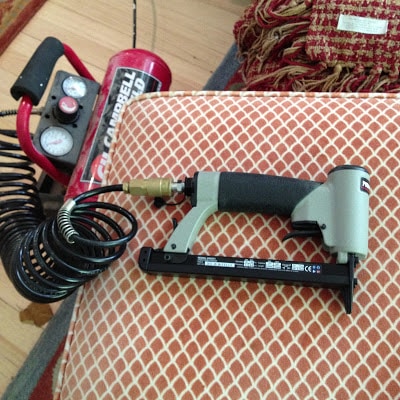 |
| New favorite power tool. |
The important thing to do is to make a lot of mental notes (or better yet, snap photos with your phone) when you take the existing fabric off. Start with any trim, which should pull right off with a few good tugs.
Then find yourself a good movie and sit down in front of the TV because this next bit is really no fun. You want to start pulling out the staples that hold the fabric on. I found it easiest to use the screwdriver to pop it up as much as possible and then use a small vice grips top pry out. If your chair is covered in a really heavy duty fabric like mine was, when you get to a certain point, you can actually pull the fabric to help pop up the staples. Just take care not to rip the fabric because it will serve as your pattern later on.
 |
| Old and faded and old and naked. |
I labeled the fabric and foam with a marker as I took it off if it wasn’t totally obvious as to what part it was from. I also saved the dust cover on the bottom to reuse.
With the chair stripped, I ironed my new fabric and laid out the old fabric on it. I laid everything for both chairs (I bought two yards of fabric) out first to make sure I was making the best use of the fabric. I also had to save some fabric for the double welt cording later on.
 |
| You can see how faded the old fabric was. I used a yardstick to line up the dots on the old fabric with the dots on the new fabric to make sure it was level. |
If you’re using a solid fabric this part is much easier because it really is a matter of just copying the fabric you’re using as a template. Patterns are a little more complicated. First of all you need to decide which way you want the fabric to run on the chair (in my case I decided the ikat dots should run horizontal). Then you need to leave a little extra room so you can line up the pattern on the chair. I cut each piece about 2 to 3 inches larger than the template fabric after making sure it was lined up horizontally.
I did not follow any of the cuts around the legs when I was cutting my fabric. Those get put in later.
I spent a lot of time lining up my fabric on the seat of the chair. I’m a stickler about patterns matching so I used a yardstick to line up the dots just so. Then I realized the chair isn’t square, so lining them up perfectly in both directions wouldn’t be possible and focused on the vertical line and did the best I could with the horizontal line.
Here’s where I’m going to tell you what you should do, and what I did on my second try, not what I actually did (which is to say that I screwed it up on the first try and had to order more fabric). To maintain the layout that I spent so long figuring out, I tacked the fabric in the center back with one staple and then pulled the fabric snug and put one staple exactly opposite it on the front underside. (I later figured out that if you’re using a pneumatic stapler, it’s best to turn psi down for these first staples to make them easier to pull out if necessary. You can always tap them all the way if they stay.) The arm braces were the most difficult obstacle to deal with, so I worked the fabric around these first. I held the fabric up and then used the pencil to draw a line following the angle of the arm brace. I then cut carefully on that line. I erred on the side of cutting less and then went back and cut more as necessary, finishing with a small tear-drop shaped cut to keep the fabric from ripping more. This cut was pulled tight between the arm and the cushion and then I rolled the fabric under to keep a nice edge and stapled it on the underside around the arm brace. I followed the same process on the other side before moving on to any other stapling.
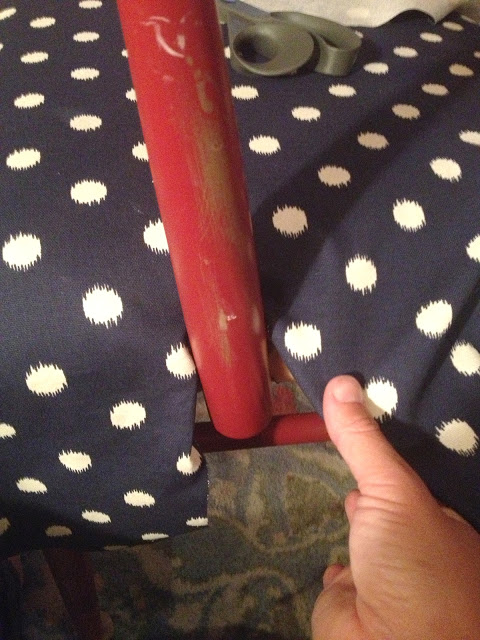 |
| Cutting and folding around the arm brace. |
With the two most difficult release cuts finished and tacked, I went back to the front and back, spacing the staples out quite a bit. When everything was set I went back and put in a billion more staples to hold everything nice and tight.
I made my way around the back to make the release cuts around the back braces the same way I did the other cuts. Smoothing out the back corners was a little tricky, but I just kept pulling the fabric taught and stapling a lot. Around the legs I just cut a little and rolled the fabric under again so the edge always looked nice.
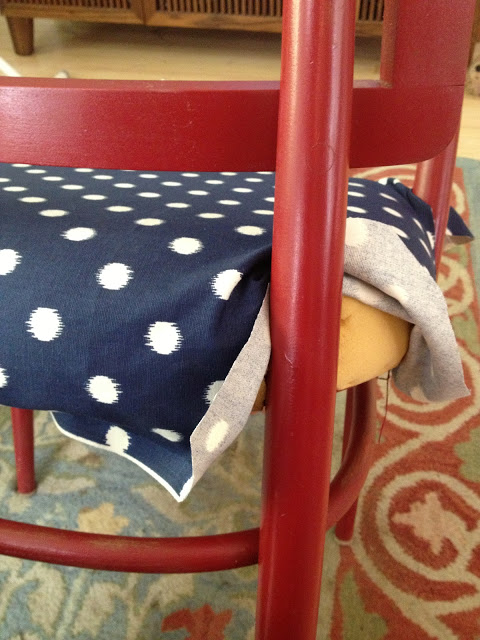 |
| With the arm brace cuts made and stapled I worked my way around to the back legs for the next cuts. |
The front corners were the last thing to get stapled because they have a little tuck in them and it was a good place to take up any extra fabric. I pulled the underside of the fold (from the side) across and tacked it underneath the chair sort of inside the leg, then created a straight tuck and smoothed the fabric with a bamboo skewer and stapled that part after rolling the edge under. Later I put a furniture tack over this one staple in front (this is how it was originally). After all that, I went back and filled in any areas that needed staples. Lots and lots of staples. Then I put the dust cover back on over the top to make it nice and neat.
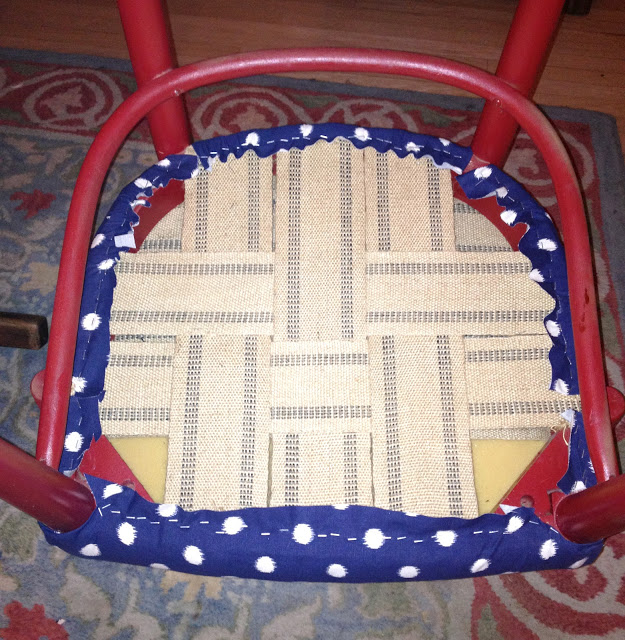 |
| Here’s what the bottom looked like when all the stapling was finished and before I put the dust cover back on. |
After all that pushing and pulling on the seat, the back of the chair was a breeze. I started with the piece of fabric that faces the back, making sure to line up the dots exactly in a line with the dots on the seat. Because the back is slightly curved, I actually did the top and the bottom first, alternating stapling one, then the other and alternating sides, pulling taught each time. Then I did the sides working out from the middle and again alternating side to side. Because the fabric I was using was pretty thin, I spaced out my staples then folded the edge over and did another staple in between through a double layer of fabric.
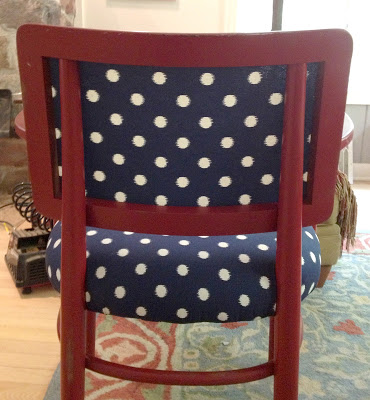 |
| I made sure to line the dots up with the seat. |
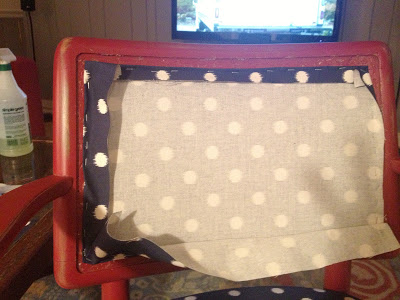 |
| First I stapled the back on one layer and then turned the fabric over and stapled through two layers for extra hold. |
Then I stuck the foam back on. It just held itself there, suspended in air.
For the front layer of the back, I again lined up the dots to continue the pattern from the seat, then stapled the entire top first (I used a row of dots to make sure I was staying even) on the underside of the fabric. This avoided having any raw edges sticking out from behind the trim at the end. Then I folded it down over the foam and folded the edge under so I was stapling through two layers of fabric. I pulled it tight and stapled three staples in the bottom row to hold it, then put a few on each side to make sure everything was nice and tight. It was a little hard to pull the fabric tight with the edge folded under so I used my needle-nosed pliers to pull the fabric while I stapled. It’s important to try to keep these rows of staples in a pretty straight line so the trim covers them nicely.
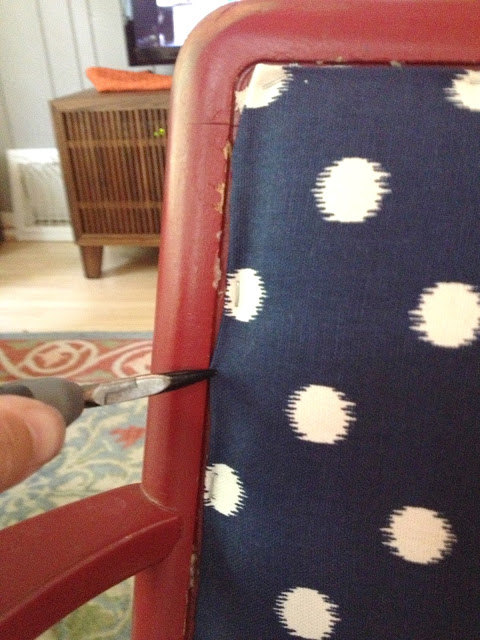 |
| I used a needle-nosed pliers to pull the folded-over fabric tight while I stapled the front. |
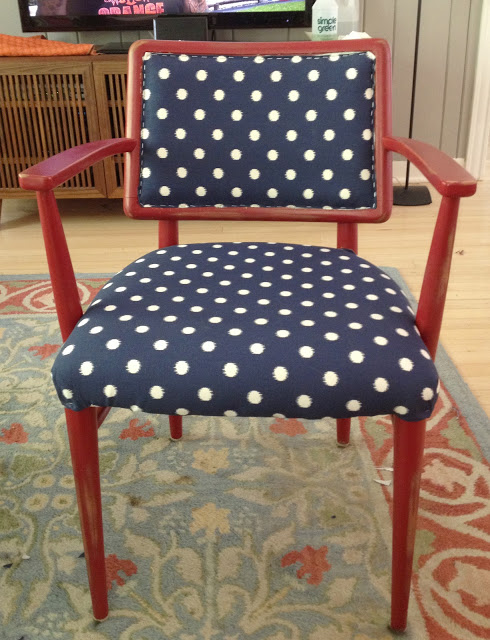 |
| Here’s what it looked like after stapling but before the trim went on to cover the staples. |
With everything stapled it was just a matter of attaching the trim. It sounds like cheating to just glue it on, but believe it or not, that’s really how it’s done. I bought some trim from the fabric store but ended up liking the look of double welt cording better.
I’m not going to get into how to sew double welt cording because me telling you how to sew is like me telling you how to perform brain surgery. I’m unqualified. I’ll just tell you that with a cording foot (I couldn’t find a double cord foot but the single cord foot worked fine) it’s not hard and I actually spent far more time reading the sewing machine directions than actually sewing the welting. Just follow this tutorial on how to make it.
When I made mine I knew I didn’t want any dots showing so I made sure to line it up so just the navy fabric would be showing. By the way, you don’t HAVE to cut your fabric for cording on the bias, it just goes around corners a little easier if you do. I’m sort of cheap about using fabric and you use a lot less if you just cut straight so that’s how I made mine. Also, it turns out that it was only $5 more to buy 250 yards of double welt cording than it was to buy 5 yards, so I now have more double welt cord than I could ever use. So if you want some for a project to try, e-mail me your address and how much you need (within reason … I’m not sending you 100 yards), let me know and I’ll send it to you. For free. Because I don’t need this much.
Anyway, if you follow that tutorial, all that’s left to do is glue it on. I just used my hot glue and stuck it on. The only tricky part was dealing with the ends. I ootched the cord out a little and nipped it off then folded the fabric over and tacked it down with glue so there wouldn’t be any fraying ends.
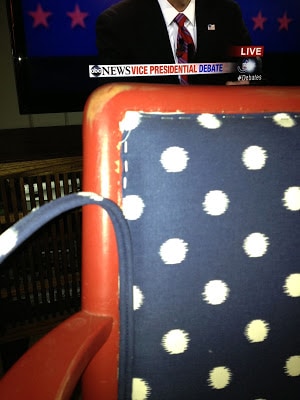 |
| Glue on the double welt to cover the staples. Scintillating television going on in the background there. |
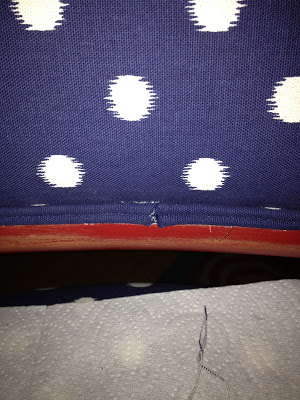 |
| I folded the ends of the fabric on the cording under and glued it to keep it from fraying. |
And that’s it. Honestly I can’t believe how good it turned out and with the exception of removing the fabric, this was one of the more fun projects I’ve done.
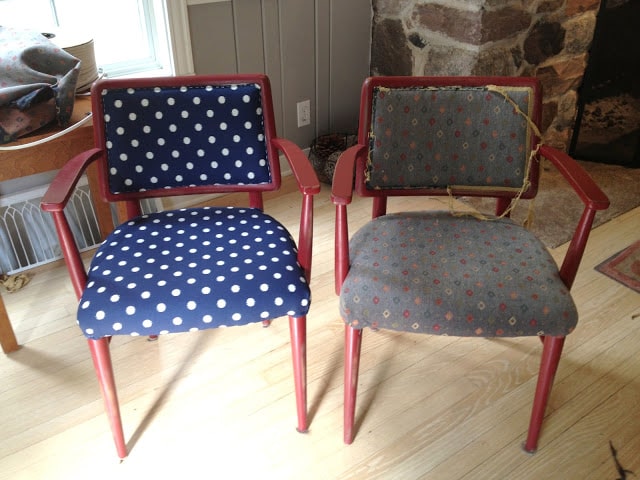 |
| Before and after (pre-trim) in the same shot. |
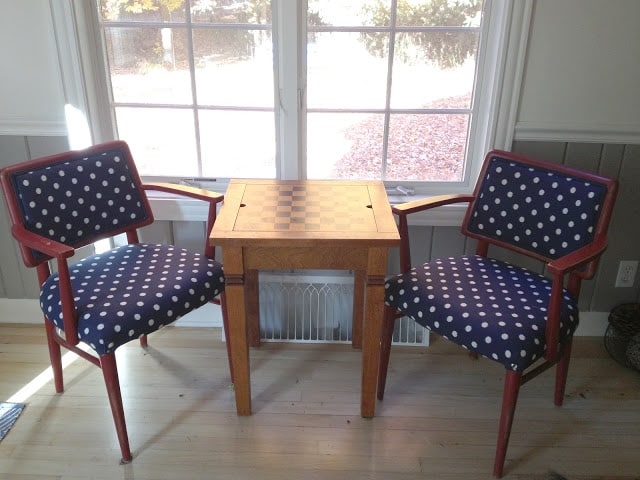 |
| After and after. |
P.S. I have a lot of these little tutorials that I find online and then later use for projects on my How-to Pinterest board. It runs the gambit of cleaning tips to DIY light fixtures, but if you’re interested in some of them, check my boards out there.
Linking up to:
What would you like to know?
Categories Here
Ads Here
Ads Here